Design and Fabrication of Laser Protective Lenses Based on Multilayered Notch Filter with Low Residual Stress and Low Surface Roughness
Abstract
:1. Introduction
2. Materials and Methods
2.1. Thin Film Preparation
2.2. Thin Film Measurement
3. Results and Discussion
4. Conclusions
Author Contributions
Funding
Institutional Review Board Statement
Informed Consent Statement
Data Availability Statement
Acknowledgments
Conflicts of Interest
References
- Zhang, J.; Tikhonravov, A.V.; Trubetskov, M.K.; Liu, Y.; Cheng, X.; Wang, Z. Design and fabrication of ultra-steep notch filters. Opt. Express 2013, 21, 21523–21529. [Google Scholar] [CrossRef] [PubMed]
- Tikhonravov, A.V.; Trubetskov, M.K.; Amotchkina, T.V.; Kokarev, M.A.; Kaiser, N.; Stenzel, O.; Wilbrandt, S.; Gäbler, D. New optimization algorithm for the synthesis of rugate optical coatings. Appl. Opt. 2006, 45, 1515–1524. [Google Scholar] [CrossRef] [PubMed]
- Allan, S.T.; Herrington, B.; Cole, C.; Mackrodt, K.; Slim, T.; Lingwood, D. Rugate coating for an avionics head-up-display. In Defense, Security, and Cockpit Displays; International Society for Optics and Photonics: Bellingham, WA, USA, 2004; Volume 5443, pp. 130–137. [Google Scholar]
- Piegari, A.; Flory, F. Optical Thin Films and Coatings: From Materials to Applications; Woodhead: Sawston, UK, 2018. [Google Scholar]
- Kumar, V.S.P.; Kumar, M.; Kumari, N.; Sharma, A.L. Design and development of an optical reflective notch filter using the ion assisted deposition technique with stepwise modulated thickness for avionics applications. Appl. Opt. 2020, 59, 564–571. [Google Scholar] [CrossRef] [PubMed]
- Shankar, A.; Kumar, S. Using a pair of antireflection layer in a minus filter to suppress ripples in the HUD-beam combiner. J. Opt. 2014, 43, 257–259. [Google Scholar] [CrossRef]
- Richter, F.; Kupfer, H.; Schlott, P.; Gessner, T.; Kaufmann, C. Optical properties and mechanical stress in SiO2/Nb2O5 multilayers. Thin Solid Films 2001, 389, 278–283. [Google Scholar] [CrossRef]
- Scherer, M.; Schallenberg, U.; Zoeller, A. High performance Notch Filter Coatings produced with PIAD and Magnetron. In Advances in Optical Thin Films III; International Society for Optics and Photonics: Bellingham, WA, USA, 2008; Volume 7101, p. 710101-10. [Google Scholar]
- Zhang, J.; Xie, Y.; Cheng, X.; Jiao, H.; Wang, Z. Thin-film thickness modulated designs for optical minus filters. Appl. Opt. 2013, 52, 5788–5793. [Google Scholar] [CrossRef] [PubMed]
- Lyngnes, O.; Kraus, J. Design of optical notch filters using apodized thickness modulation. Appl. Opt. 2014, 53, A21–A26. [Google Scholar] [CrossRef] [PubMed]
- Hoggan, R.N.; Subhash, A.; Blair, S.; Digre, K.B.; Baggaley, S.K.; Gordon, J.; Brennan, K.C.; Warner, J.E.A.; Crum, A.V.; Katz, B.J. Thin-film optical notch filter spectacle coatis for the treatment of migraine and photophobia. J. Clin. Neurosci. 2016, 28, 71–76. [Google Scholar] [CrossRef] [PubMed] [Green Version]
- Kumar, M.; Kumari, N.; Sharma, A.L.; Karar, V.; Sinha, R.K. Design and fabrication of reflective notch filter using modified thickness modulated Al2O3-SiO2 multilayer. In Optical Interference Coatings; Optical Society of America: Washington, DC, USA, 2019. [Google Scholar]
- MacLeod, H.A. Thin-Film Optical Filters, 4th ed.; CRC Press: Boca Raton, FL, USA, 2010. [Google Scholar]
- Tien, C.L.; Zeng, H.D. Measuring residual stress of anisotropic thin film by fast Fourier transform. Opt. Express 2010, 18, 16594–16600. [Google Scholar] [CrossRef] [PubMed]
- Takeda, M.; Ina, H.; Kobayashi, S. Fourier-transform method of fringe-pattern analysis for computer-based topography and interferometry. Appl. Opt. 1982, 72, 156–160. [Google Scholar] [CrossRef]
- Stoney, G.G. The tension of metallic films deposited by electrolysis. Proc. R. Soc. Lond. 1909, 86, 172–175. [Google Scholar]
- Tien, C.L.; Yang, H.M.; Liu, M.C. The measurement of surface roughness of optical thin films based on fast Fourier transform. Thin Solid Film 2009, 517, 5110–5115. [Google Scholar] [CrossRef]
- Tien, C.L.; Yu, K.C.; Tsai, T.Y.; Lin, C.S.; Li, C.Y. Measurement of surface roughness of thin films by a hybrid interference microscope with different phase algorithms. Appl. Opt. 2014, 53, H213–H219. [Google Scholar] [CrossRef] [PubMed]
- Elsholz, F.; Schöll, E.; Rosenfeld, A. Control of surface roughness in amorphous thin-film growth. Appl. Phys. Lett. 2004, 84, 4167–4169. [Google Scholar] [CrossRef]
- Tien, C.L.; Chen, K.P.; Lin, H.Y. Internal stress prediction and measurement of mid-infrared multilayer thin films. Materials 2021, 14, 1101. [Google Scholar] [CrossRef] [PubMed]
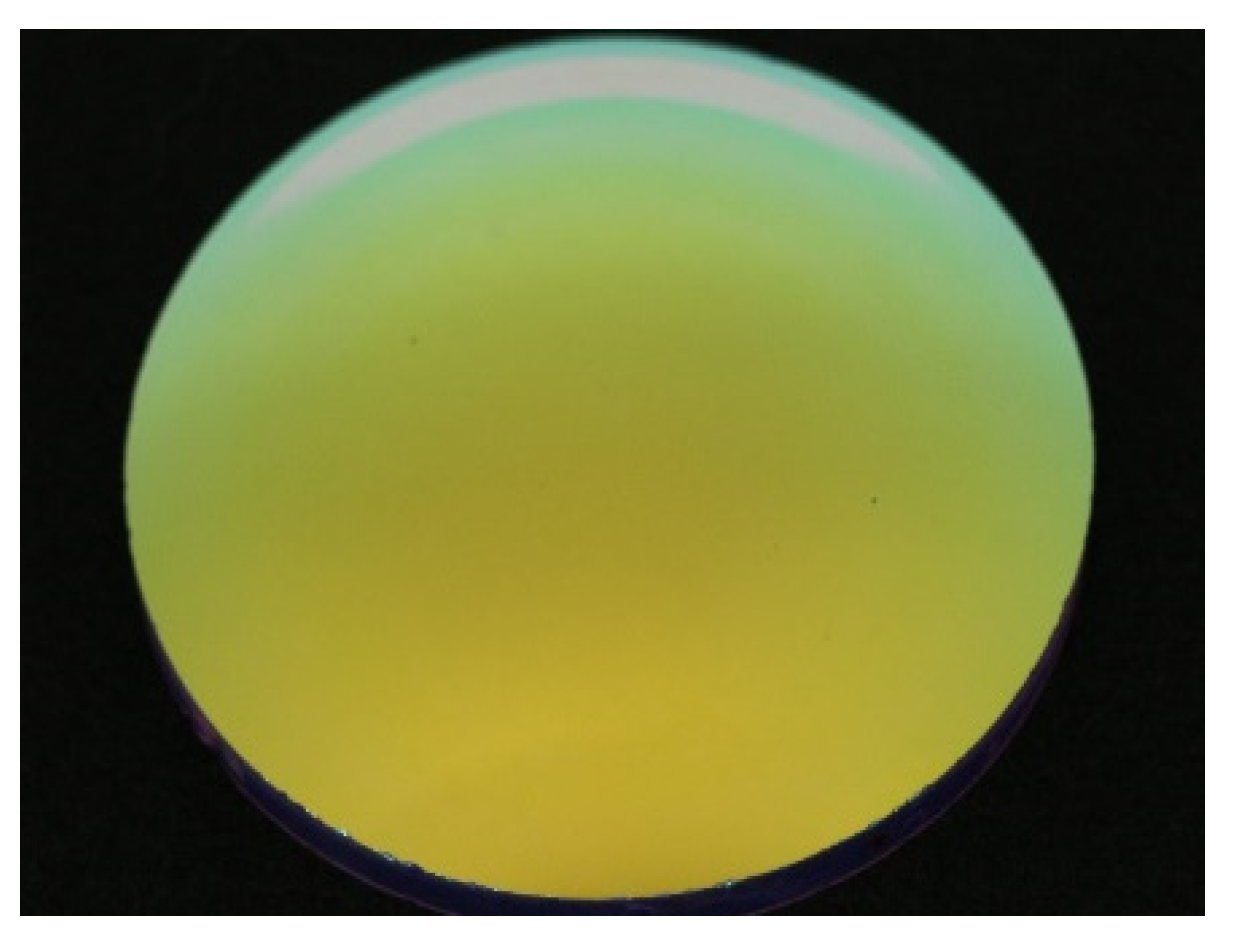


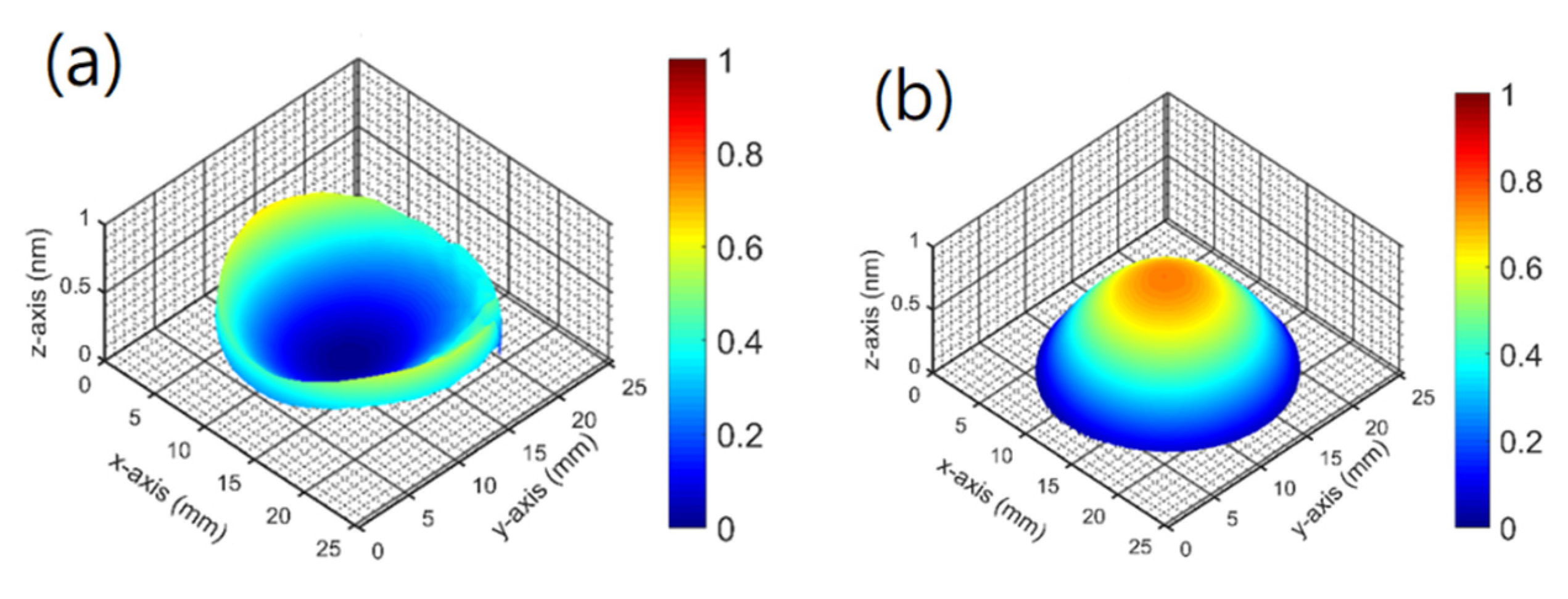
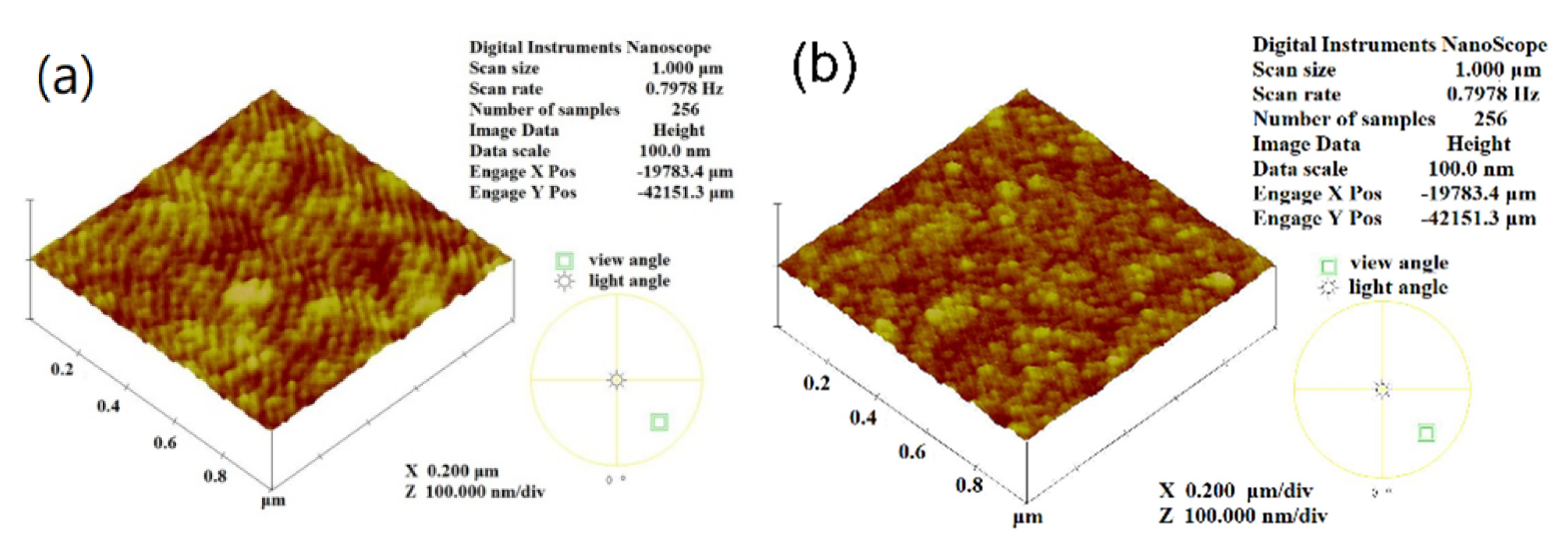
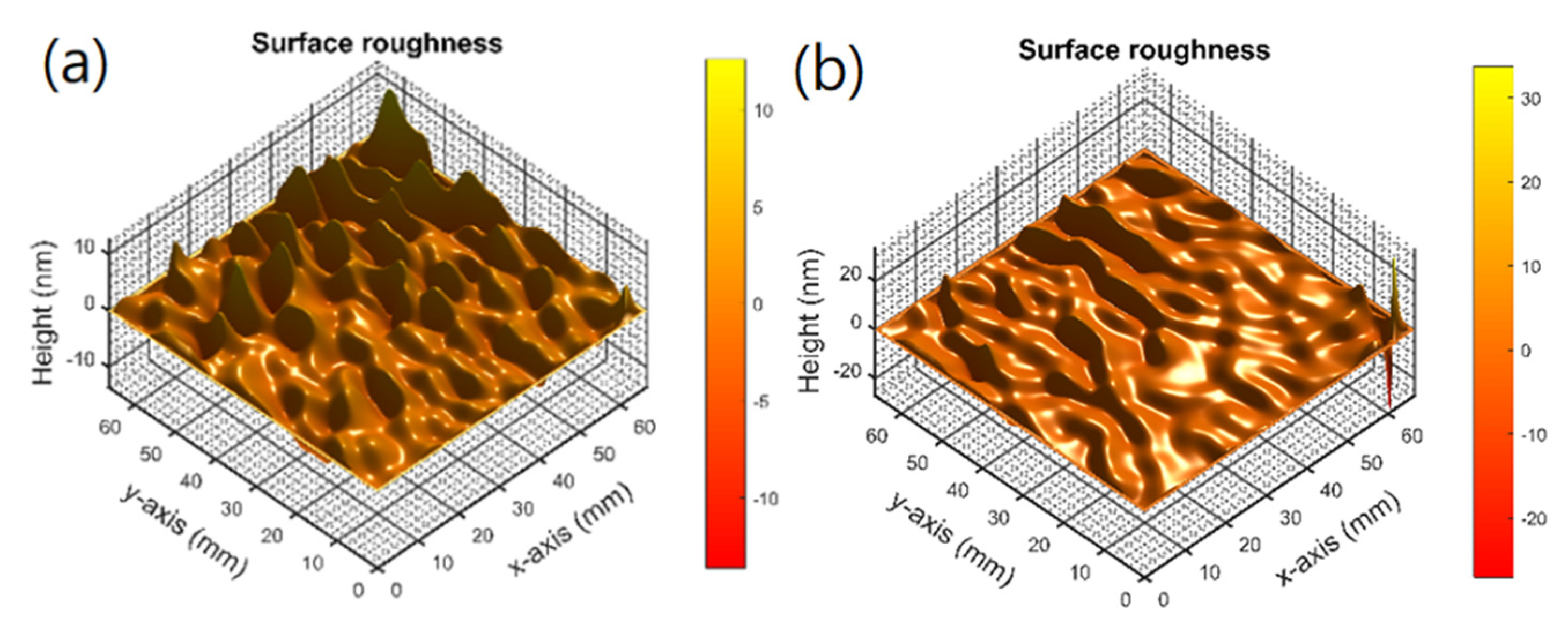
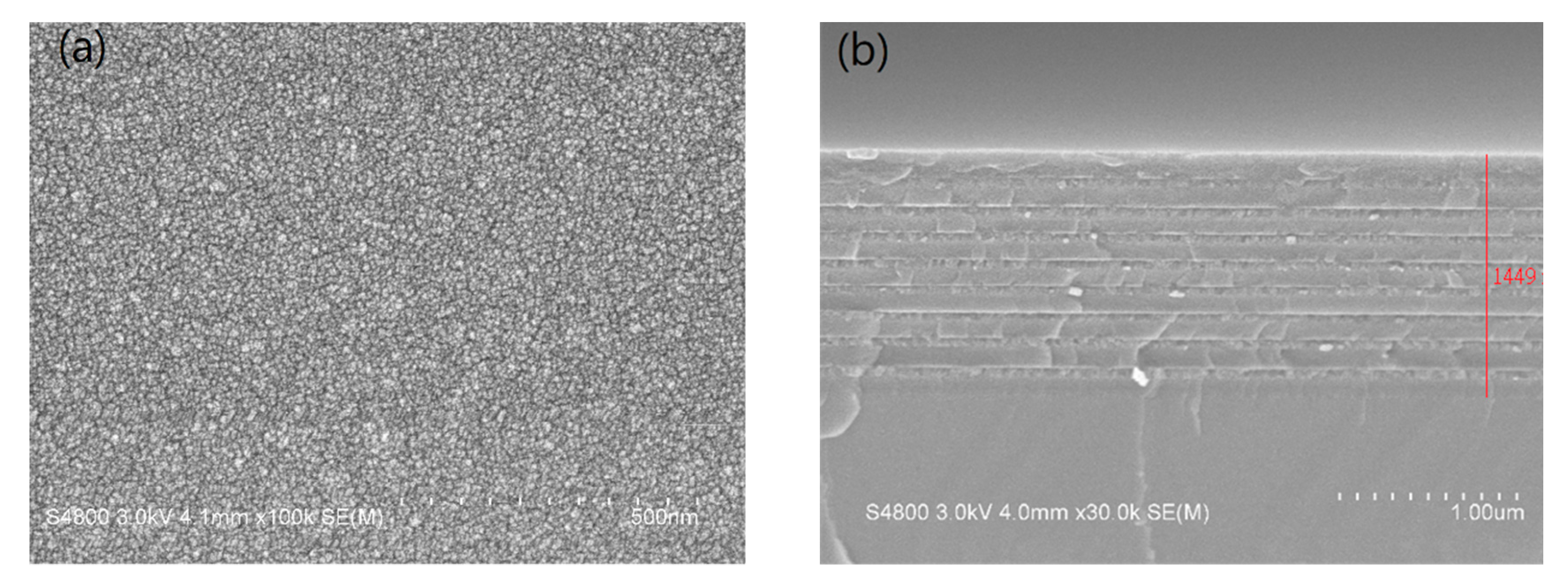
Publisher’s Note: MDPI stays neutral with regard to jurisdictional claims in published maps and institutional affiliations. |
© 2021 by the authors. Licensee MDPI, Basel, Switzerland. This article is an open access article distributed under the terms and conditions of the Creative Commons Attribution (CC BY) license (https://creativecommons.org/licenses/by/4.0/).
Share and Cite
Tien, C.-L.; Lin, H.-Y.; Cheng, K.-S.; Chang, C.-K. Design and Fabrication of Laser Protective Lenses Based on Multilayered Notch Filter with Low Residual Stress and Low Surface Roughness. Coatings 2021, 11, 1513. https://doi.org/10.3390/coatings11121513
Tien C-L, Lin H-Y, Cheng K-S, Chang C-K. Design and Fabrication of Laser Protective Lenses Based on Multilayered Notch Filter with Low Residual Stress and Low Surface Roughness. Coatings. 2021; 11(12):1513. https://doi.org/10.3390/coatings11121513
Chicago/Turabian StyleTien, Chuen-Lin, Hong-Yi Lin, Kuan-Sheng Cheng, and Chih-Kai Chang. 2021. "Design and Fabrication of Laser Protective Lenses Based on Multilayered Notch Filter with Low Residual Stress and Low Surface Roughness" Coatings 11, no. 12: 1513. https://doi.org/10.3390/coatings11121513





